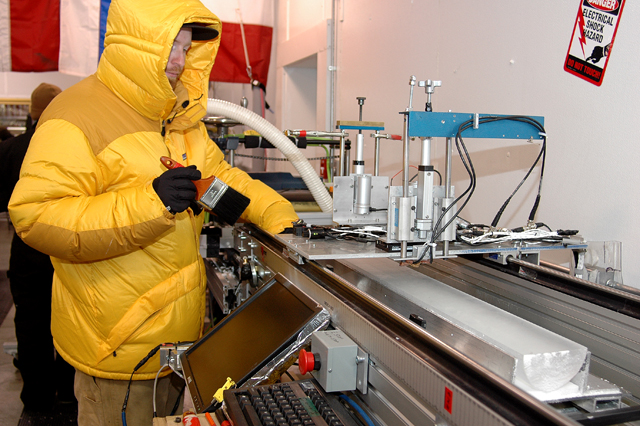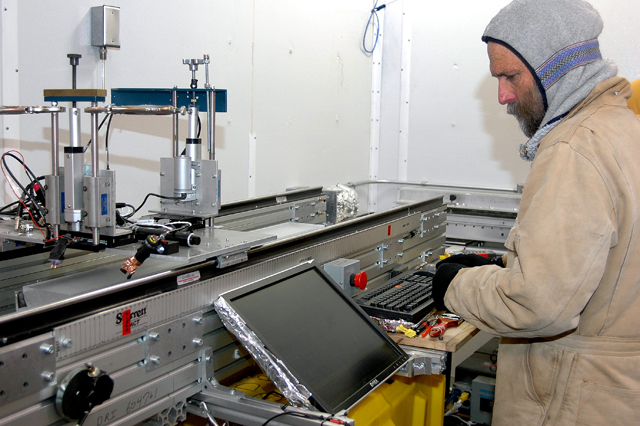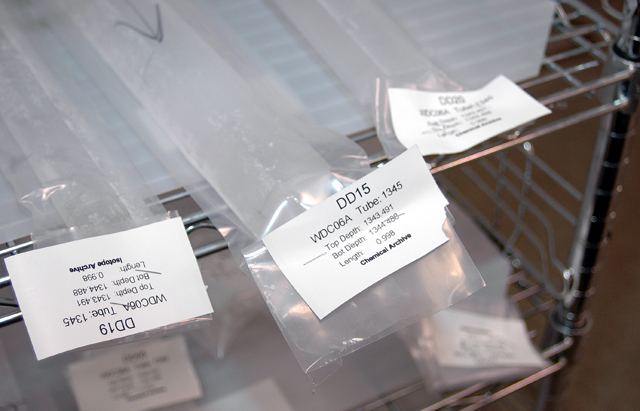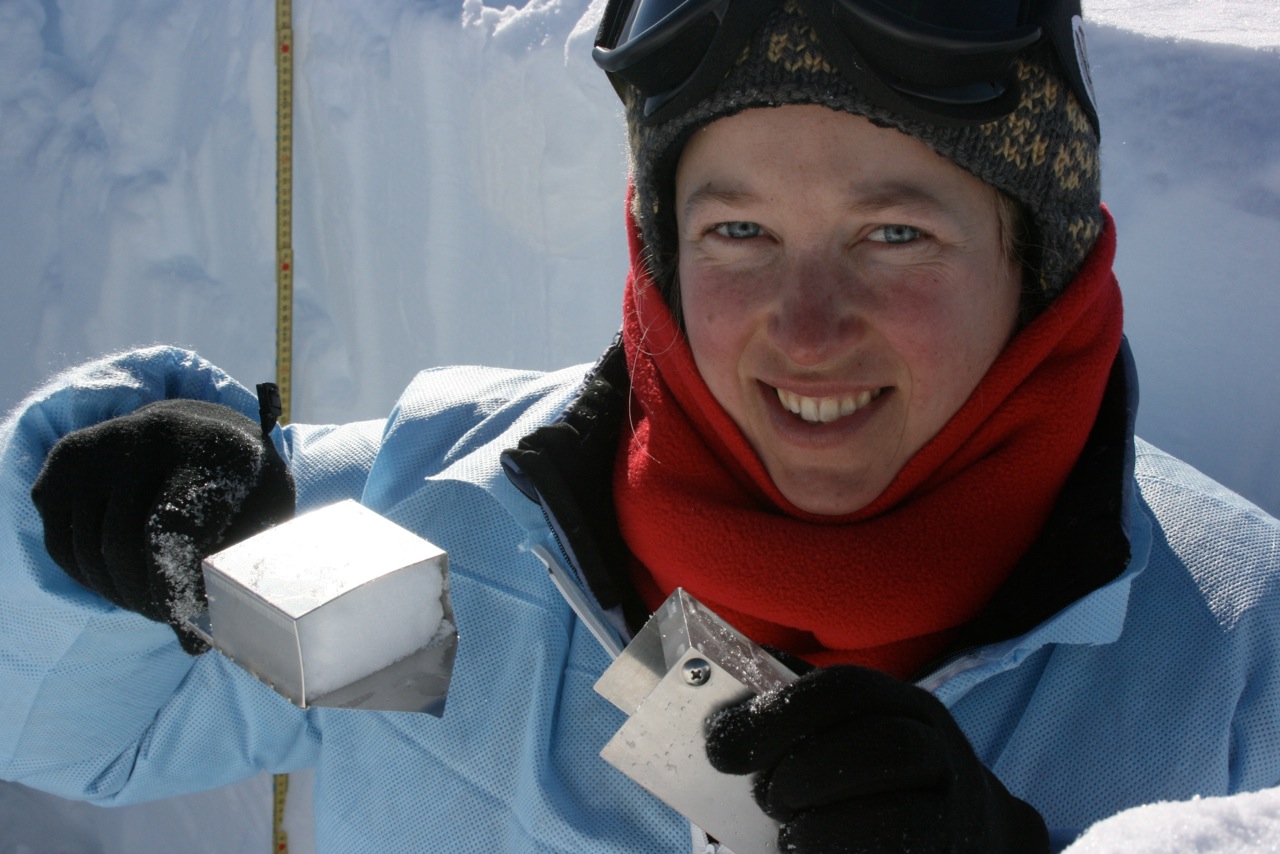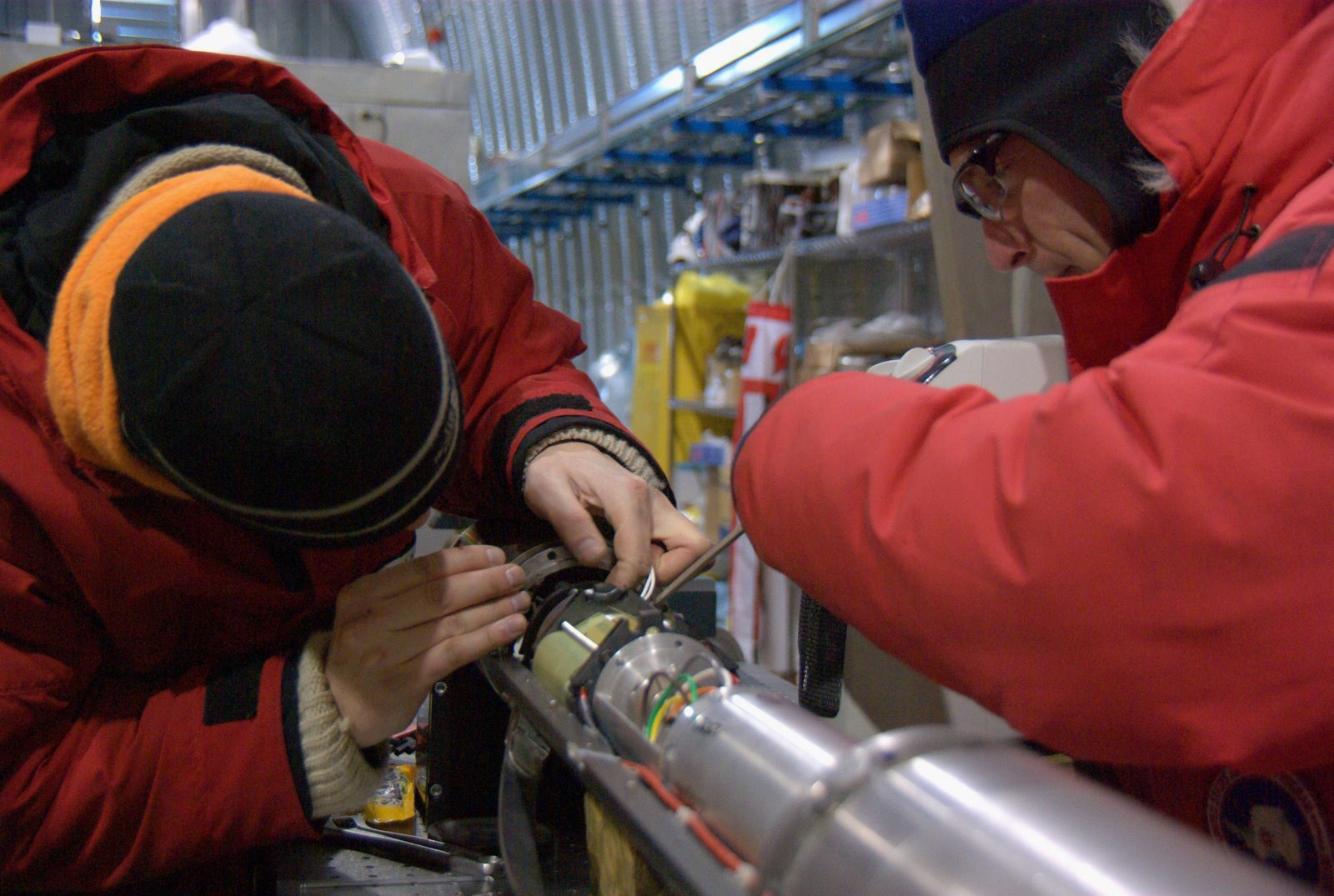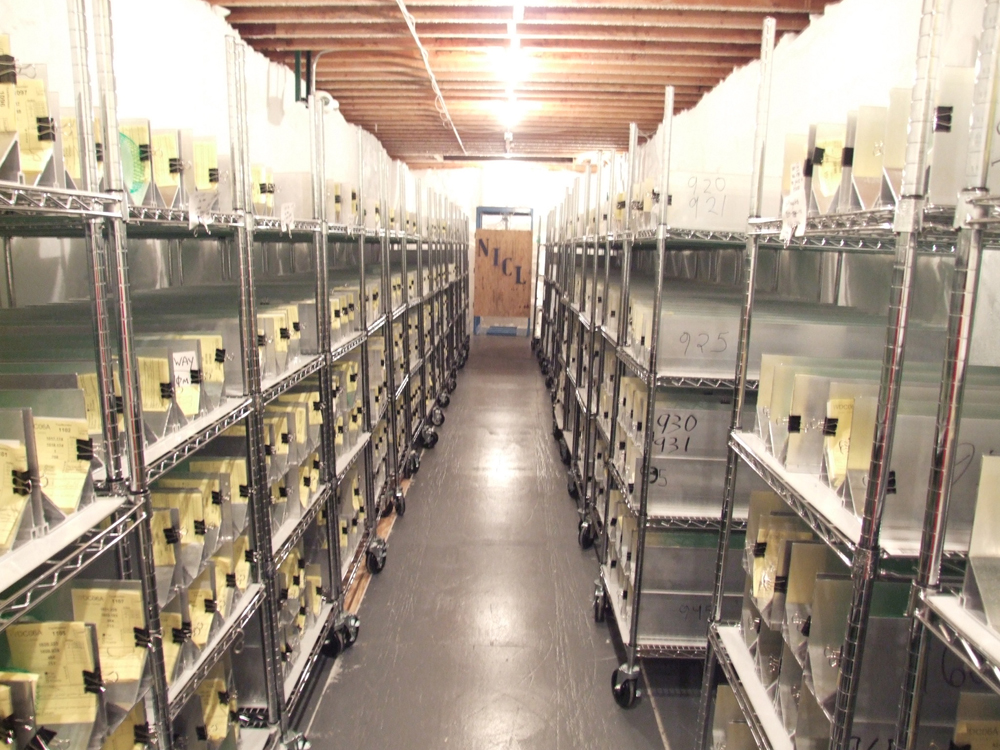
IT'S MIDSUMMER IN DENVER, and the city has been baking under a heat wave for a couple of months. But in one small corner of the sprawling Denver Federal Center campus in the nearby suburb of Lakewood, about a dozen people are bundled up in thickly insulated Carhartt jumpsuits, wool caps, scarves and gloves.
The constant whine of saws in the room echoes loudly, like some busy school woodshop class. But there's no smell of woodchips in the air. In fact, it's hard to smell anything with a runny nose that begins almost immediately upon stepping into the freezing cold lab where scientists are slicing and dicing ice.
And not just any ice. This is ice from Antarctica, extracted from the middle of the West Antarctic Ice Sheet (WAIS) by the world's most advanced ice-coring drill. Researchers from across the United States will eventually analyze various properties of the ice to reconstruct the last 100,000 years of climatic and atmospheric conditions.
The results will lead to one of the most detailed histories of the last glacial period, when ice sheets once blanketed parts of North America. The information about the past will also help scientists better understand the links between climate change and greenhouse gases, as the world continues to warm in the 21st century.
But first those hundreds of meters of ice cores—which have traveled thousands of kilometers from Antarctica by ship, plane and truck—must be processed.
That's where the National Ice Core Laboratory (NICL), a facility managed by the U.S. Geological Survey at the Denver Federal Center and mostly funded by the National Science Foundation (NSF), comes in.
Getting in line
Researchers from around the country, including young scientists working on their doctorates, spent part of their summer at NICL helping to measure, catalog, cut and ship pieces of the ice core to their respective universities and laboratories.
The operation is called the core processing line, or CPL.
"This is the most challenging CPL we've had at the National Ice Core Lab in terms of the amount of ice, the number of projects that are involved in it, the complexity of the sampling, and the coordination of all the groups," said Kendrick Taylor, the chief scientist for WAIS Divide Ice Core, a $30 million project funded by the NSF.
"We've got a really good group of people. Everyone is in super good spirits, which is amazing considering the working environment," added Taylor, a thickly bearded research professor at the Desert Research Institute in Nevada.
The CPL team has less than three months to work its way through 1,400 meters of ice. Most people will spend up to eight hours a day in the CPL lab, which stays at a constant minus 23 degrees Celsius, with plenty of breaks to warm up. It's even colder in NICL's main storage warehouse, at minus 34 centigrade, where some 17,000 meters of ice cores from around the world are stored.
"It's kind of brutal with the temperature changes," said T.J. Fudge, a PhD student from the University of Washington who recently arrived at NICL. Fudge will help run a machine that measures the electrical conductivity of the ice by running electrodes along the length of an ice core section that's been split and planed smooth.
Electrical conductivity varies seasonally, offering a way to define and date the layers of the ice core in conjunction with other methods, such as visual stratigraphy, which involves putting a trained eye on each one- meter-long core section.
That job falls to Matt Spencer, an assistant professor in the department of geology and physics at Lake Superior State University. Spencer learned how to read the nuances of ice cores—the bleeding of one summer storm into another, a dark layer that could indicate a change in chemistry—while working on the Siple Dome ice core project in Antarctica more than 10 years ago.
It's a rare skill, one that Spencer has volunteered to the CPL team for the summer. He spends his time in a small enclosure shrouded by a black curtain. The core slides along a conveyer belt of rollers into the darkroom, illuminated only by a light table. Spencer bobs his head and shifts his body to peer at the chunk of ice from every possible angle.
"It's really the luck of the draw what you find here in terms of good annual [layers] and bad annual [layers]," he explained.
For instance, at a depth of about 1,362 meters, each layer is roughly 15 centimeters wide. But one section seems about double that breadth. There's probably a divide in there somewhere—but where?
"Where the divide is between those two years is sometimes arbitrary," he said. Other analyses will help sort out the ambiguity.
Slicing and dicing
At the front of the CPL, where the core handlers are using lasers to measure the length of each section of core before the cutting and examinations begin, precision is of utmost importance.
"This is probably the most critical part for us right now—making sure we get a good length. This is what's going to give us the true depth of the ice we're hauling up out of the hole," explained Geoffrey Hargreaves, NICL curator since 1993.
Together with the electrical conductivity measurements, the length measurements provide an age-to-depth relationship, which is important for the subsequent analyses involving chemistry, isotopes and gases, according to Hargreaves.
"Without good age, without good depth control, you've got nothing," he said.
Then the ice is ready for various dissections. Top sections are cut into different slabs that are ripped and chopped into smaller pieces depending on what they'll be used to measure. For example, 3-centimeter-square sticks of ice will be used for different chemical measurements covering 70 percent of the elements in the periodic table.
The chemistry can reveal information about past conditions such as sea ice extent, the amount of dust in the atmosphere and even seasonal changes, which reveals clues to the environmental conditions of the time.
The other half of the core then undergoes the electrical conductivity measurement before a camera creates a high-resolution scan. Spencer then makes his visual inspection before pushing the core farther down the line where some of the best sections are removed for later gas analysis, particularly carbon dioxide, methane and nitrous oxide.
"The gas guys get the best ice," Hargreaves noted.
Currently, the CPL chews through about 35 meters of ice in a day. The best day so far was 39 meters. "That's when everything is working," Spencer said.
At each step along the way the team members log the core sections before they disappear into plastic casings and insulated boxes destined for individual labs across the country. About a third or more of each core section will remain untouched, returned to its tube and the deep-freeze warehouse. The CPL database will eventually be merged into the NICL database to ensure the inventory in the freezer is up to date.
"I know exactly what's in the tube sitting on the shelf. It makes it a lot easier to come back when somebody is looking for ice," Hargreaves said.
The archive at NICL includes ice that was retrieved in 1958 at the Little America V station during the International Geophysical Year, when the modern era in polar science began. The oldest ice dates from the Vostok core, some 400,000 years.
As technologies change and improve, scientists still request samples from ice that's been in the collection for decades.
"We resample cores from 15 to 20 years ago all the time," Taylor said.
From beginning to end
The WAIS Divide project is the first ice-coring venture in which NICL staff has been involved from when the ice first emerges from the borehole in Antarctica to when it enters the CPL sawmill.
"It makes sense that we who handle the ice in the end should be there in the beginning to make sure it starts in the right way," Hargreaves said.
Spruce Schoenenmann has experienced both the cold of the freezer room at WAIS Divide and at NICL as a science technician responsible for handling the core. And he'll see some of the same ice a third time when he finally melts it for analysis in the lab at the University of Washington, where he is a PhD student under WAIS Divide principal investigator (PI) Eric Steig.
"I will see it all the way through from start to finish," Schoenenmann said.
Taylor noted that many of the graduate students at NICL will handle the ice multiple times before it is melted and the water sucked into a spectrometer or other instrument for analysis. Many have their PhDs riding on the results.
"That's great because they have a very vested interest in making sure [the CPL is] done right," Taylor said.
Most of the technicians who head south to Antarctica are hired for the project because they are involved directly in the research or plan to continue their education in a related field, according to Mark Twickler, manager of the WAIS Divide Science Coordination Office (SCO). The WAIS Divide SCO, based at the University of New Hampshire, manages the day-to-day operations of the project.
"It's interesting; a lot of the PIs now that are working on the ice core were graduate students during the GISP-2 days," said Twickler, referring to an ice core project in Greenland during the 1990s.
"It was a great training experience for the students. The same thing is true today with the students coming to NICL and the science techs going down. We're still trying to get people field experience and ice-processing experience," he added.
The Greenland ice core project is partly responsible for Bess Koffman becoming a polar scientist.
During her junior year at college, she heard a lecture by the well-known glaciologist Richard Alley of Penn State University about the discoveries from the GISP-2 core. She read his book on the subject, The Two-Mile Time Machine, and two years later she was on the Ice working as a field technician at the U.S. Antarctic Program's Palmer Station.
Now a PhD student at the University of Maine, Koffman sees the experience of doing the grunt work involved in ice-core drilling and handling, in both Antarctica and at NICL, as an important lesson on the path of her academic career.
"The ability to participate in every step of the process has allowed me to see my PhD research in the context of the whole. I really feel part of the overall WAIS Divide community," said Koffman, who is busy back at her lab melting water from the upper meters of the core for analysis. She worked at the WAIS Divide field camp in 2008-09 and 2009-10.
Her research focuses on the role of atmospheric dust in the climate system that can be found in the ice. She is particularly interested in understanding how dust controls iron geochemistry in the ocean. Iron is an important but limited nutrient for phytoplankton growth in the Southern Ocean.
"Aerosol iron fertilization of photosynthetic algae can lead to decreased atmospheric CO2 concentrations," Koffman explained. "Dust indirectly modulates this greenhouse gas."
New methodologies
Schoenenmann, a tall, lean man with a fondness for rock climbing, is interested in developing a new methodology for measuring the stable isotope oxygen-17. The work will provide new information on the sea surface humidity during the Last Glacial Maximum (LGM), when the last glacial period peaked about 20,000 years ago.
Previous research indicated conditions were dry, but other data suggest the humidity may have been higher, accompanied by more precipitation, according to Schoenenmann. He hopes the O17 record will shed more light on the issue.
"It's really an exciting new measurement," he said. "The WAIS Divide record will be the first one to have an O17 record."
Thomas Bauska is another PhD student who has worked in the Middle of Nowhere, West Antarctica, on the ice-coring project. He was at WAIS Divide during the most recent field season, when the drill reached a bottom depth of 2,560 meters.
Like Schoenenmann, he has developed a new methodology to analyze stable isotopes in the gases trapped in the ice— in this case, carbon-12 and carbon-13 —working in the laboratory with WAIS Divide PI Ed Brook at Oregon State University.
The gas measurements are perhaps some of the most exciting because they will address a central question regarding the relationship between carbon dioxide and temperature.
Current ice core records show that in the past temperature increased, followed several centuries later by an increase in carbon dioxide—but there is still a large uncertainty in the timing of this sequence.
Most scientists believe past climate warming was caused by variations in the Earth's orbit, called Milankovitch cycles, which changed how sunlight was distributed on the surface of the planet. But the orbital changes alone are probably not enough to end an ice age, just to initiate environmental changes that allow more carbon dioxide into the atmosphere to create the greenhouse effect.
"Humans are now increasing the level of CO2 in the atmosphere to levels higher than at any time in the last 800,000 years," Taylor explained. "The effect will be similar to what happened when changes in the Earth's orbit caused the oceans to release CO2: No change for awhile, then lots of warming and changes in rainfall on a scale that humans have never experienced."
By studying ice cores, which record how this process worked in the past, scientists will be able to predict more accurately how human releases of CO2 will affect climate. Specifically, the analysis of the ancient ice by Bauska and others will identify the sources of CO2 and help figure out why it varies naturally.
"You need the large amount of samples that WAIS Divide can give us to make these measurements," Bauska noted.
Ice time
Results from the work by young scientists like Schoenenmann, Koffman, Fudge, Bauska and the many PIs are still well down the road, according to Taylor. Only about 600 meters of ice has been processed previously, containing the most recent 2,000 years of climate history.
"That's the annoying thing with the ice cores. You drill them, and it can be like two years before the ice gets to the lab. It's another year or two of measurements. And then another couple of years to figure out what it [means]," Taylor mused.
The brittle ice being processed this summer was originally cored from the ice sheet during the brief 2008-09 field season. It had to spend a year on site before it could be moved to allow the ice to "relax" so it would not become brittle and get damaged during transport to the United States.
The delay is partly due to the need for conducting the CPL and the different analyses back in the United States. That's in contrast to projects like GISP-2, Greenland Ice Sheet Project 2, or the recently completed North Greenland Eemian Ice Drilling project, which hit bedrock last month.
In Greenland, the scientists make many measurements in a snow trench carved out for that purpose. However, it's too expensive to bring all of the equipment and people needed for such an operation to West Antarctica, where the field camp is reached by a ski-equipped military aircraft when the weather is good enough to fly.
"Going to Greenland is like a vacation compared to a place like WAIS Divide, where it takes at least three weeks just to come and join us for lunch," Taylor said.
By the time the CPL crew reaches about 2,000 meters in mid-August, the climate record will reach back about 8,000 years. The first 40,000 years are expected to be thick enough for the annual layers to be counted before the ice flow makes the layers too thin to resolve.
Taylor said he is hopeful that the drilling team will reach its final target depth of 3,330 meters during the 2010-11 season, bringing back another 1,400 meters of ice for next summer's CPL.
"We're really looking forward to pushing that last piece of ice through the drill," Taylor said.

